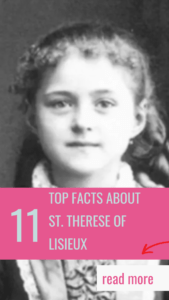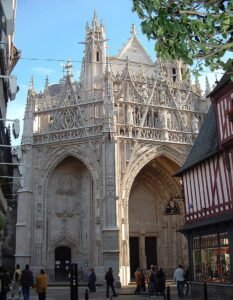St. Thérèse of Lisieux: Top 11 Joyful Spirituality Aspects of Her Shining Light for Our Times
Come and explore the beautiful spirituality of St. Thérèse of Lisieux, the beloved Catholic saint known as the “Little Flower”! In this extensive blog post, we’ll dive into the inspiring life and faith of St. Thérèse of Lisieux. You’ll discover why this young Carmelite nun from France who died at only 24 years old still captivates millions worldwide today.
Learn all about St. Thérèse’s “Little Way” of holiness, her miraculous intercession from heaven, the significance of roses in her story, and how to visit the relics and sites of this luminous saint in Lisieux. Whether you are new to her teachings or already devoted, this post will help deepen your connection to St. Thérèse of Lisieux!

When was St. Thérèse of Lisieux Born and When Did She Die?
St. Thérèse of Lisieux was born Marie Françoise-Thérèse Martin on January 2, 1873 in Alençon, France. She was the youngest of nine children born to Louis and Zélie Martin. Five of the Martin daughters became nuns, showing just how devout this family was. Thérèse’s mother tragically died from breast cancer when Thérèse was only four years old.
After her mother’s passing, Thérèse became very attached to her older sister Pauline who became like a second mother to her. Thérèse was a very sensitive child who suffered from nervous tremors. But she was also very pious from a young age. By the time she was eleven, Thérèse expressed her desire to enter the Carmelite monastery. At fifteen, she received special permission to join her older sisters in the convent at Lisieux.
On entering the monastery, Thérèse took the name Sister Thérèse of the Child Jesus and the Holy Face. As a quiet, humble sister, she lived in the convent attending to her religious duties, meditating, and praying for souls. In the last years of her life, she suffered greatly from tuberculosis and passed away on September 30, 1897 at the young age of twenty-four.
What Order Did St. Thérèse of Lisieux Belong To?
St. Thérèse became a nun in the Carmelite Order at the monastery in Lisieux, France when she was only fifteen. The Carmelite Order is devoted to contemplative prayer, simple living, and making sacrifices for the salvation of humanity. The nuns typically live cloistered lives, leaving the monastery only for urgent necessities like medical care.
St. Thérèse lived as a Carmelite nun from 1888 until her death in 1897. She took the religious name Sister Thérèse of the Child Jesus and the Holy Face upon joining the Lisieux convent. The Carmelites seek to grow in holiness and devotion to Christ through a regimen of silence, manual labor, prayer, and sacrifice. Their spirituality emphasizes detachment from worldly possessions and ambitions. St. Thérèse embraced this simple, modest lifestyle during her years as a nun.
What is St. Thérèse of Lisieux the Patron Saint Of?
St. Thérèse of Lisieux is the patron saint of several causes, primarily missionaries, florists, aviators, and people suffering from AIDS.
She is the patron saint of missionaries because of her fervent prayers and devotion to priests and the salvation of souls across the globe. Although Thérèse never served as a missionary herself, she prayed ceaselessly for missionaries to succeed in spreading the Gospel.
Florists have adopted St. Thérèse as their patron because of the many miracles involving roses attributed to her intercession. Thérèse promised to send down “a shower of roses” after her death, and devotees have reported receiving roses as a sign of her spiritual presence.
Aviators also look to St. Thérèse for guidance as their patron saint, although she died long before airplanes were invented. Some stories tell of her benevolent spiritual presence miraculously guiding pilots through dangerous situations.
Finally, St. Thérèse is the patron saint of people impacted by HIV/AIDS. As someone who suffered greatly from disease, Thérèse serves as a model of hope and resilience for those managing serious illness.

What Were Some Key Events in the Life of St. Thérèse of Lisieux?
Some significant events that shaped St. Thérèse’s spiritual life include:
– The early death of her mother when she was only four years old, leading to an intense attachment to her older sister Pauline.
– Her Christmas conversion at age 13 when she shed her childhood sensitivity and embraced the radical call of faith.
– Entering the Carmelite monastery at 15, beginning her religious life as a contemplative nun.
– Her struggle in 1895 when her faith was tested by spiritual dryness; her revival with complete trust in God’s mercy.
– Her miraculous healing from serious illness through the intercession of the Virgin Mary.
– Being elected assistant novice mistress despite her young age, offering guidance to new nuns.
– The onset of her final illness, severe tuberculosis, which she bore with grace and joy.
– Her death at only 24 years old on September 30, 1897 after much physical suffering.
These impactful moments reveal her unwavering devotion to Christ even amidst difficulties like doubt, illness, and the turbulence of youth.
What is St. Thérèse of Lisieux Best Known For?
St. Thérèse of Lisieux is best known for her spiritual memoir The Story of a Soul which introduced her “Little Way” approach to holiness. The core of her spirituality is doing even mundane tasks with great love out of devotion to God.
Thérèse described her Little Way as her personal, childlike spirituality of simplicity and trust. She emphasized practicing small acts of love in each moment, instead of worrying about making grand gestures. Thérèse wrote that she wished to remain small and unnoticed, like a child nestled into its father’s arms.
The Little Way appealed to Catholics worldwide who struggled to find holiness in everyday life. Thérèse demonstrated how small sacrifices borne out of love have great value to God. She inspired millions to cultivate devotion through their modest daily activities.
Ultimately, Thérèse is remembered for making sanctity feel accessible for ordinary Catholics. She assured people they could grow closer to God through little acts, intentions, and prayers woven into each day.
What Miracles Are Attributed to St. Thérèse of Lisieux?
Numerous miraculous cures and interventions have been attributed to St. Thérèse’s intercession in heaven. She said during her lifetime, “After my death, I will let fall a shower of roses. I will spend my heaven doing good upon earth.” Since her passing, believers worldwide have reported experiencing roses as a sign of her spiritual presence.
Some examples of miracles associated with Thérèse include:
– An Ohio boy run over by a wagon had his crushed leg healed through Thérèse’s intercession.
– A nun with tuberculosis was suddenly cured after praying novenas to Thérèse.
– Thérèse’s father had eye problems healed after praying for her help.
– A pilot whose plane ran out of fuel landed safely after calling on Thérèse.
– Severely ill children made sudden full recoveries after their families prayed to the saint.
– Paralyzed individuals have regained the ability to walk through her intercession.
These miraculous interventions were critical in the Catholic Church’s decision to canonize Thérèse as an official saint and name her a Doctor of the Church. To this day, thousands continue to report miraculous healings and aid from St. Thérèse of Lisieux.

Where Can You Go to See Relics of St. Thérèse of Lisieux?
The primary relics of St. Thérèse are housed at the Carmelite convent in Lisieux, France where she lived as a nun. Visitors can see her relics at the Chapelle Sainte-Thérèse and the Basilica of St. Thérèse, located next to the convent.
Some key sites associated with Thérèse in Lisieux include:
– The Crypt Chapel, where her relics rest and Mass is celebrated
– The Basilica, which contains her relics and grave
– The Carmelite convent and St. Thérèse museum displaying her artifacts
– Les Buissonets, Thérèse’s restored childhood home
– The Cathedral where she took her first communion
– Zélie’s House, residence of Thérèse’s mother
Making a pilgrimage to Lisieux is the best way to connect with St. Thérèse and follow in her footsteps. Beyond Lisieux, other French churches have small relics like her hair, clothing, letters, or pieces of her casket. These can be found at various Carmelite convents and sites like the Notre Dame Basilica in Paris.

How Can I Make a Catholic Pilgrimage to See St. Thérèse of Lisieux?
Here are some tips for planning a pilgrimage to see relics and sites related to St. Thérèse:
– Look into pilgrimage tour groups that arrange travel to Lisieux and other saint sites around France. This simplifies logistics.
– Book tickets to travel to Lisieux or Paris, then arrange local transportation to sacred sites by train, bus, or car.
– Get travel documents like passports, visas, and travel insurance in order well in advance.
– Study about St. Thérèse’s life so you fully appreciate the significance of visiting her relics and convent.
– In Lisieux, stay at hotels near the Basilica like La Maison Sainte Thérèse for easy access to sites.
– Allow several days to see key churches, relics, museums, and landmarks significant to the saint.
– Participate in spiritual activities like going to Mass, attending pilgrim blessings, praying novenas, and reflecting in the convent gardens.
– Purchase mementos like holy medals, prayer cards, roses, or statues of St. Thérèse from area shops.
With some careful planning, a pilgrimage can greatly enrich your faith and connection to beloved saints like St. Thérèse of Lisieux.

What Other Saints Are in France?
France has produced dozens of renowned Catholic saints spanning back to the early history of the Church. Some other major French saints to know about include:
– Joan of Arc, the courageous martyr and national heroine who helped drive British forces from France in the 15th century
– King Louis IX, a model of Christian virtues and chivalry who led two Crusades
– Denis, the third century bishop and patron saint of France who was beheaded for spreading Christianity
– Bernard of Clairvaux, the eminent theologian and founder of the Cistercian monastic order in the 12th century
– Genevieve, the patron saint of Paris who reportedly saved the city from invading armies in 451 AD
– Vincent de Paul, known for his vast charities serving the sick and poor in the 17th century
– John Vianney, the 18th century patron of priests who was renowned for his preaching and service in the village of Ars
– Catherine Labouré, a Daughter of Charity nun who reported seeing visions of the Miraculous Medal in 1830
– Bernadette Soubirous, the young visionary from Lourdes who saw apparitions of the Virgin Mary in 1858

Making Travel Arrangements to See St. Thérèse of Lisieux
Visiting the relics and sites of St. Thérèse in Lisieux is the best way to gain inspiration from this beloved saint. Here are some tips for making travel arrangements for a smooth and rewarding pilgrimage:
– Book tickets for travel into Paris or directly into Lisieux through the Caen Carpiquet Airport. Flying or taking the train are the most efficient options.
– Arrange local transportation like car rentals, trains, or tours to get around Lisieux and surrounding areas like Rouen. Walking is feasible for getting around the pilgrimage sites downtown.
– Plan accommodation at hotels close to the Basilica of St. Thérèse like Le Patio or La Maison Sainte Thérèse. This allows easy access to relics and historic sites.
– Allow enough time in Lisieux – ideally 2-3 days – to see the Basilica, Crypt Chapel, Carmelite Convent & Museum, and other landmarks at an unhurried pace.
– Get any entry tickets to sites like the museum, guided tours, or crypt tomb area ahead of time when possible. Some sell out.
– Consider attending Mass at the Crypt or Basilica to enrich your spiritual experience. Check schedules for English services.
– Purchase train/bus tickets for side trips to Rouen, Paris, or other relevant French cities in advance to save money and hassle.
– Walking is the best way to get around Lisieux’s compact downtown area. Bring comfortable shoes!
With some planning, your journey to see St. Thérèse can be a profoundly rewarding pilgrimage.
I’ve been all over the place. America, Scotland, Korea, Hong Kong, Macau, The Vatican, Switzerland, France, Milan, and all of Israel are among the countries I’ve visited. Very soon, I’ll be in Turkey.
I am well-versed in all facets of travel. I’ve provided a few straightforward tools to assist you in preparing for your holiday.
- Find cheap flights for your journey HERE
- A Car Rental
- Taxi Drivers
- Bus or Train Tickets
- Choose the Perfect Hotel for Your Trip HERE
- Fun Events for Your Journey
- Travel Insurance
- Phone for Traveling
Time to pack your bags! 🙂
What is the Significance of Roses in Relation to St. Thérèse of Lisieux?
Roses have special meaning in Catholic devotion related to St. Thérèse of Lisieux. She stated near her death, “After my death I will let fall a shower of roses.” Since then, roses have come to symbolize her spiritual presence and miraculous intercession from heaven.
When Thérèse promised to “let fall a shower of roses” it signified these key ideas:
– Roses indicate she is lifting souls to God’s merciful love after her death, like a gentle rainfall brings flowers to bloom.
– The rose shower represents the graces and miracles she bestows on people who pray earnestly for her aid.
– Thérèse sends roses as heavenly messages to faithful devotees, reminding them they are loved by Christ.
– The rose is a sign of God’s presence amidst life’s thorns, just as Thérèse found joy despite suffering.
Catholics have reported extraordinary encounters with roses after praying to Thérèse. Roses frequently appear in conjunction with healings, conversions, and other blessings attributed to her intercession. Across the world, devotees turn to Thérèse for a rose in times of trial.
In iconography, St. Thérèse is often depicted holding roses, showered by roses from heaven, or with roses at her feet. Beautiful depictions of Thérèse and symbolic roses can be found in churches, prayer cards, medals, and artwork. For millions, the humble flower is forever linked with St. Thérèse’s promise of guidance from above.

How Can St. Thérèse of Lisieux Help Make Me a Saint?
St. Thérèse of Lisieux sets a beautiful example of attaining sanctity amidst ordinary life. Through her Little Way spirituality, she guides us in living out holiness in our daily activities, intentions, and sacrifices. Thérèse shows us how to make each moment an opportunity to grow closer to God.
As an accessible saint who found joy despite suffering, Thérèse gives hope that we too can become saints. She assists us through her guidance and miraculous intercession from heaven. Here are some key ways St. Thérèse can help us on the journey toward sainthood in our own lives:
– By reminding us that sanctity lies in small acts done with great love. We do not have to achieve grand feats, but should instead focus on offering many little virtues.
– Through encouraging childlike trust and total surrender to God’s will. Like Thérèse, we can lay all our concerns at Jesus’ feet.
– By showing that holiness blossoms when we humbly accept our limitations and weaknesses. Our frailty makes room for God’s grace.
– Through interceding for us and obtaining blessings, healings, and aid as we emulate her Little Way. We can ask for her heavenly support.
– By motivating us to practice the Corporal and Spiritual Works of Mercy to serve others with compassion. This was key to Thérèse’s mission.
– Through providing wisdom via her writings and life story. We can learn from her testimony and apply her teachings.
– By inspiring us to also seek the heights of sanctity amidst daily life. With Thérèse’s help, we too can become saints!
St. Thérèse led a cloistered life in a convent, yet her example and teachings are profoundly relevant today. By leaning on her guidance, we will be well on our way to becoming the saints God calls us to be. Let us turn often to the Little Flower, St. Thérèse, for assistance as we walk the path to holiness.
Are You Inspired?
Do you feel inspired or motivated in any manner as a result of today’s lessons on the St. Therese of Lisieux? Saints’ biographies provide for stimulating reading and conversation. It has a great chance of producing spiritual fruit in our lives.
Would you like a simple method to discuss the saints with your friends and family? Why don’t you get one of these amazing St. Therese of Lisieux shirts that I created especially for you? You can then tell them about St. Therese of Lisieux when they inquire about the meaning of your shirt in this manner.
They could even agree to accompany you to church. Better yet, you might be able to share the Gospel with them. All persons have sinned and fall short of God’s glory, according to Romans 3:23. As a result, everyone requires a Savior.
God sent His one and only son to complete the requirements of the law as a way of making provision for us to become His children. Rom. 4:15–16
In order to provide the ultimate atonement for our sins, Jesus had to come to Earth, live a sinless life, and die. The Bible states it this way…
“Indeed, under the law almost everything is purified with blood, and without the shedding of blood there is no forgiveness of sins.”
– Hebrews 9:22
Jesus’ crucifixion and death were not the end of the story, though. No, he came back to life! Because He is alive, He promises to bring us back to life once we pass away. He conquered death and sin for all time. Hallelujah!
After you’ve given your family, friends, and acquaintances this life-saving knowledge, ask them to RCIA at their neighborhood Catholic church.
Family members, friends, and acquaintances can join the Catholic Church and become able to receive the Holy Sacraments through the Rite of Christian Initiation for Adults, or RCIA. By taking part in RCIA programs offered by their parish, students can learn everything they need to know about our magnificent Christian religion and our Compassionate Jesus.
This is the real way to save a life. In this, I’m wishing for you!
To view the St. Therese of Lisieux shirt design, click HERE or on the image. To go to the payment page, select your preferred size and color, then click the BUY NOW button.
You can visit our website by clicking HERE for a list of further well-known saints.

After learning about the St. Therese of Lisieux, do you have a few more minutes to research another saint?
Why not investigate:
- “St Therese 24 Glory be Novena”: This Shockingly Simple Prayer Will Transform Your Spiritual Life
- 15 Prayer of St Bridget: Transform Your Spiritual Life with St. Bridget’s 15 Prayers
- Discover the 5 Day Novena to St Therese the Little Flower That Will Transform Your Prayer Life
- Feel Christ’s Presence With the “St Kateri Tekakwitha Prayer” – Our Top 15 Facts & Exclusive Guide
After reading the St Therese of Lisieux, have you ever thought about coming back to this page every day to discover more about the Saint of the Day? Please take a moment to sign up if you’d like to receive my daily saint emails in your inbox. I’ll keep it short since I know you have a lot on your plate, but I’ll say more because I want you to learn something from me and constantly aspire to do better.
I’ll offer you a Mother Mary Printable as a free gift to put up in your home or place of business! I will email you a link to download it as soon as you submit the form.
Enjoy!
Well, that’s all for today.
I’ll see you back tomorrow with another Saint of the Day to inspire you!
God bless you,
-Priscilla




